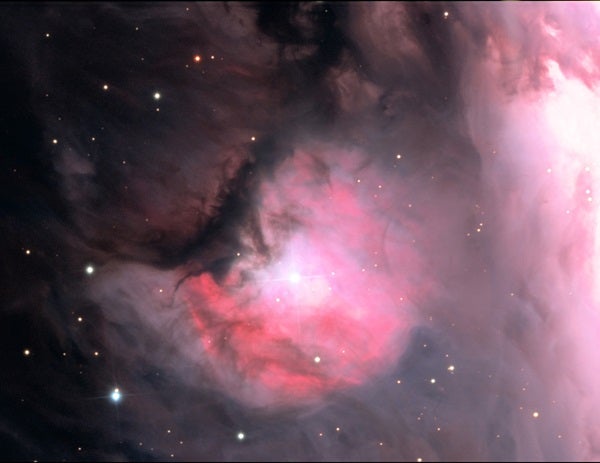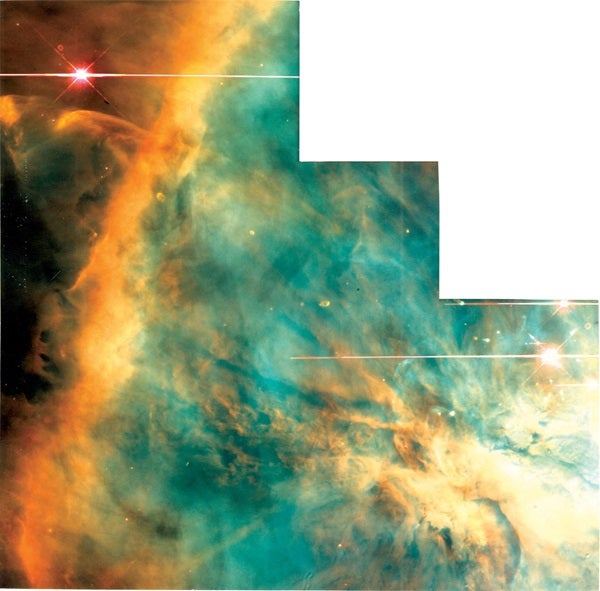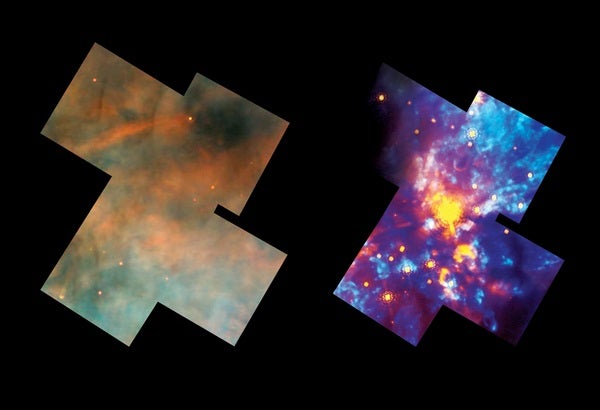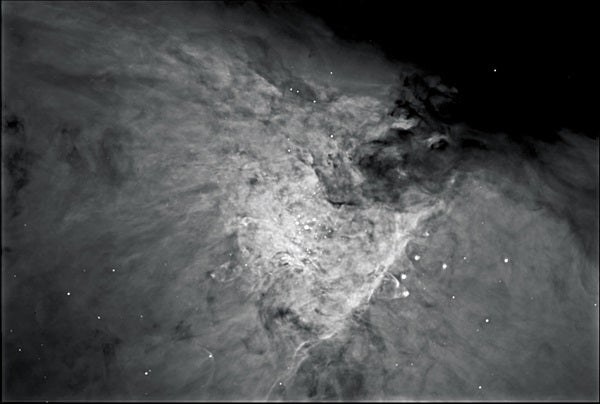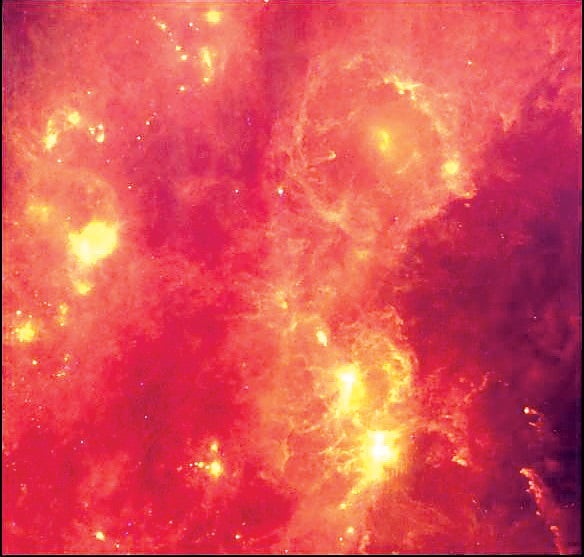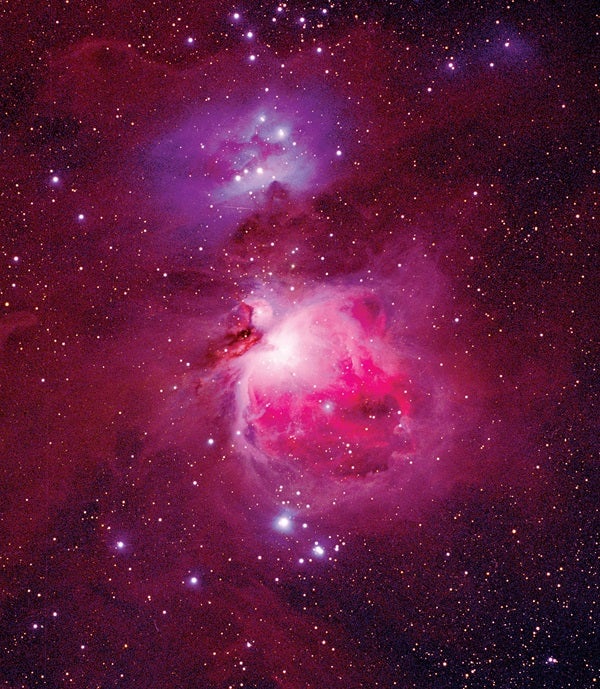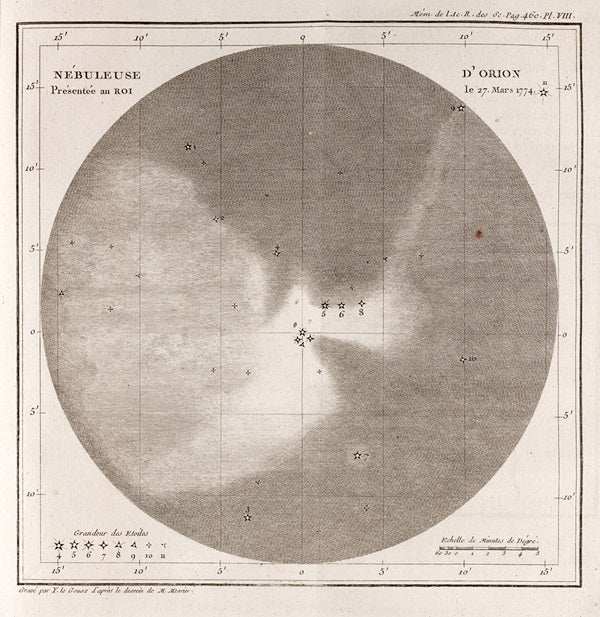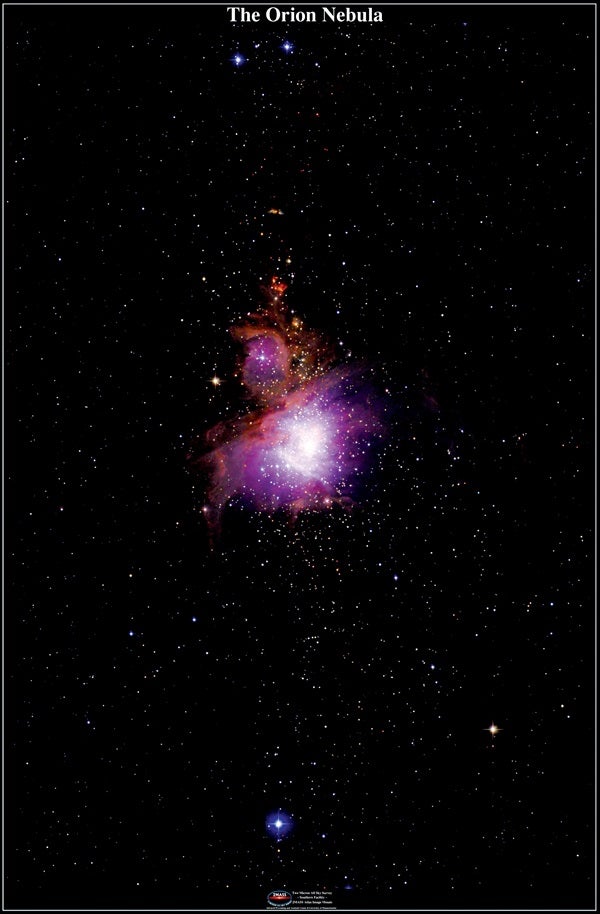The Orion Nebula (M42) is so named because it lies within Orion the Hunter, a constellation that dominates the winter sky. To find the nebula, look below Orion’s Belt where his sword hangs. Your eyes alone will see the center star as fuzzy. Binoculars help, but also reveal more fuzz. Look through a telescope, however, and you’ll never forget it. For here lies one of the showpiece celestial objects — a stellar nursery that, after being observed for hundreds of years, still has a lot to reveal.
Stellar neighborhood
The Orion Nebula’s position in our galaxy is well-known. If we could view the Milky Way from above, it would appear as a pinwheel with four spiral arms. The galaxy contains hundreds of billions of stars and massive amounts of gas and dust. Our solar system resides in the Orion Spur, which sits between the Perseus and Sagittarius arms, about halfway out from the galactic center.
Our earthbound view is different. On a clear summer night in the Northern Hemisphere, the Milky Way’s glow stretches from Cassiopeia in the northeast to Scorpius in the south. From this vantage point, we’re looking along the galaxy’s rim. Toward Scorpius is the central part of the Milky Way. Rather than seeing a field of blazing stars, our view is obscured by huge clouds of dust and gas.
In the winter, we see the sky opposite the stellar traffic jam found toward the galaxy’s center. The winter Milky Way is there, but you need a dark sky to see it with unaided eyes. The winter sky is the brightest of the seasonal skies — it contains the highest concentration of bright stars — and its most famous representative is Orion.
Although the background sky is fainter here than in summer, this area still contains much of the gas and dust that’s so prevalent throughout the galaxy. In fact, the Orion Nebula represents only the tip of the proverbial iceberg. M42 is a small part of a huge complex called the Orion Molecular Cloud (OMC). Actually, this complex is divided into OMC-1 and OMC-2. OMC-1 lies only 1′ northwest of the Trapezium — a small cluster of newly formed stars at the Orion Nebula’s heart — and contains all the visible nebulae.
Observing M42
Today, just as in the time of William Herschel (1738–1822), getting a new telescope means taking a look at the Orion Nebula. It represents a benchmark to which we can compare other deep-sky objects.
Nineteenth-century astronomy popularizer Garrett P. Serviss noted the middle star in the sword — Theta1 (θ1) Orionis — resolves into the famous Trapezium even through the smallest of telescopes. He described it as an “irregular square shining in a black gap in the nebula.”
To the unaided eye, the Trapezium appears as a single star. When viewed through a telescope at low power, the “star” splits into four — designated, from west to east, as A, B, C, and D, with C being the brightest. A larger telescope with higher magnification reveals two more (E and F), and the largest amateur scopes may show G and H (which constitute a double star).
English observer William Henry Smyth (1788–1865) in his famous Cycle of Celestial Objects (1844) referred to the nebulosity that surrounded the Trapezium as the Fish’s Head. Other early observers also noticed this aquatic similarity. Sir John Herschel (1792–1871), son of William, compared the nebulosity “to a curdling liquid or a surface strewn over with flocks of wool.”
Despite what high-resolution Hubble Space Telescope images or even photographs taken by amateur astronomers show, it is difficult to see colors in the nebula. Through telescopes, some observers have reported a hint of green or purple in the clouds surrounding the central stars.
Before photography, capturing an image of the Orion Nebula depended on a skilled observer with a keen eye and an artistic hand. Dutch astronomer Christiaan Huygens’ (1629–1695) early drawing shows only a smudge with an indentation and three stars. M42 drawn by French comet-hunter Charles Messier is detailed and clearly shows the visual impression left by the nebula.
Photography began in the 1830s but was cumbersome. Before the first photographic image of M42, American astronomer George Phillips Bond (1825–1865) produced a drawing of M42 that ranks as the most beautiful and detailed ever made. Bond was the director of the Harvard College Observatory during the American Civil War and used observations of the Orion Nebula through a 15-inch refractor over many years to render this detailed image. The original drawing still hangs at Harvard University.
American astronomer Henry Draper (1837–1882) captured the first photographic image of the Orion Nebula on September 30, 1880. Draper used an 11-inch Alvan Clark refractor with a triplet objective. He also used a new “dry-plate” photographic technique to make his images. The exposure lasted 50 minutes. Since that night in 1880, astronomers have scrutinized M42 through every size telescope and in every available band of the electromagnetic spectrum.
Inner turmoil
The Orion Nebula is about 1,350 light-years away and more than 10 light-years across. Yet it represents only a small part of the great Orion Molecular Cloud. The cloud contains a mixture of cold hydrogen and dust grains. M42 is known as an emission nebula. The hydrogen is excited by the hot stars buried within. Excitation is a process by which hydrogen atoms absorb energy (from nearby stars). The atoms can’t hold the energy for long, however, and quickly release it as light.
The Orion Nebula is a hotbed of star formation. The stars in and near the Trapezium are young — possibly only 300,000 years old. Theta1 C Orionis contains 40 times the Sun’s mass and has a surface temperature of 40,000 kelvin (72,000 degrees Fahrenheit). Because of its size and mass, Theta1 C produces tremendous amounts of ultraviolet radiation, which causes nearby gas clouds to fluoresce. Theta1 C is 210,000 times brighter than the Sun, and it produces a stellar wind that blows at 5.7 million mph (9.2 million km/h). This tremendous wind blows planet-forming dust particles away from the surrounding stars, making it impossible for planets to form.
Conditions within the Orion Nebula are incredible. In The Perfect Storm by Sebastian Junger, two massive atmospheric fronts collide over the Atlantic Ocean to create killer waves. A perfect storm of cosmic proportions is taking place in M42. Disks of dust and gas surround small, low-mass stars that produce stellar winds. The supersonic stellar wind of Theta1 C collides with the stars’ winds, producing the perfect cosmic storm. This storm will continue as long as the supermassive star continues to produce energy. If we could run time forward even a million years, we’d see Theta1 C obliterate itself in a supernova.
No matter how much we know about the physical nature of this complex region, the Orion Nebula never fails to delight when seen for the first time or after many years. When first shown Orion, children relate the shape of this constellation to a bow tie, an hourglass, or even a butterfly. In the latter case, the great nebula marks one of the colorful spots on its wing.
However you see this giant constellation, it’s filled with wonders beyond imagination. Nearby and just above M42, one can find M43. Above M43 is the Running Man Nebula (NGC 1973–5–7). Still, the complexity of the Orion Nebula and the surrounding area only hints at the beauty and drama of our galaxy.
Who saw it first?
The credit for the first telescopic identification of the Orion Nebula should go to Italian astronomer Nicholas Peiresc (1580–1637), who made notes in 1610. They remained unpublished for many years, and Jesuit priest Johann Baptist Cysat “rediscovered” the fuzzy patch in 1618.
Scientists give most of the credit to Dutch astronomer Christiaan Huygens (1629–1695). Huygens’ list of accomplishments is breathtaking: He developed the pendulum clock, invented the balance wheel for mechanical watches, and formulated a wave theory of light.
He was also an avid observer. Huygens built and used several long-focal-length refracting telescopes. In his 1659 book, Systema Saturnium (in which he correctly identified the nature of Saturn’s rings), Huygens published the first drawing of the Orion Nebula.
Near the end of the 18th century, English astronomer William Herschel turned one of his first telescopes on this cosmic wonder. Herschel continued to build bigger telescopes, which culminated with a scope containing a 48-inch mirror. This instrument gave bright, detailed views of celestial objects but was hard to maneuver. The Orion Nebula was the last object Herschel viewed through this telescope before he retired the ungainly beast.
French comet hunter Charles Messier (1730–1817) was the one who really put the Orion Nebula on the map. In 1758, Messier spotted what would become known as the Crab Nebula. He made it the first entry — M1 — in his now-famous catalog of deep-sky objects. By 1769, Messier had developed a list of 41 objects he wanted to publish.
To wrap up the project, Messier added four objects: the Orion Nebula (M42), a separate part of the Orion Nebula (M43), the Beehive open cluster (M44), and the Pleiades (M45). Messier’s list eventually totaled 109 objects, but few capture observers’ interest like No. 42.
Galileo and the Orion Nebula
Why didn’t Galileo, who made so many telescopic discoveries, record the Great Nebula in Orion? We might understand how he could overlook a faint outer planet like Neptune, but how could he have missed a fuzzy patch visible to the naked eye?
As always, reality is more complex than it seems at first glance. Flandrau Planetarium in Tucson, Arizona, has displayed an exact replica of one of Galileo’s telescopes for many years. One look through this primitive instrument (mounted so visitors can view with it), and you’ll realize just how incredible his discoveries were.
Galileo made his first telescopes while living in Venice. The “figure” of the glass lenses was done by trial and error, and the glass may have been full of air bubbles. Perhaps Galileo thought the fuzzy nature of the region in Orion’s Sword had more to do with his instrument than with the true nature of the object.
Mythic surroundings
Greek mythology provides many stories about Orion the Hunter. One myth says that the gods placed Orion in the sky as a punishment for his arrogance. Another declares Orion was in love with the beautiful goddess Diana. Diana’s brother, Apollo, was enraged by this relationship and tricked Diana into killing Orion with one of her arrows.
Another story claims Orion threatened to kill all animal life on Earth. To prevent this, the Earth goddess, Gaia, sent a scorpion that stung Orion on the heel, killing him. Regretting her actions, Gaia placed Orion opposite Scorpius the Scorpion in the sky so Orion could never be harmed again. Any star chart shows this arrangement.
The ancient Egyptians saw Orion as the god Osiris, the husband of Isis. Seth killed his brother Osiris in an ancient rivalry. To make certain the job was complete, Seth chopped Osiris into 14 pieces and scattered them throughout Egypt.
Isis recovered all but one part and placed Osiris in the sky (as the constellation Orion), where he could be seen by all. Osiris became a pre-Christian symbol of death and resurrection because Orion sets in the springtime when crops are being planted and reappears when the crops have been harvested.
The Greeks told similar stories emphasizing Orion’s timekeeping nature. The poet Aratus wrote a book, Phaenomena, around 200 b.c. The long poem is really a calendar guide that gives directions about nature and the passage of the year.
Even T.H. White captures Orion’s calendric use in his book The Sword in the Stone when he has the young Wart — the future King Arthur — looking through a castle window at Orion, hoping spring will arrive soon. Perhaps Wart looked at the giant’s gleaming sword and thought of Excalibur.
As the civilizations of Greece and then Rome eventually collapsed, the growing power of Islam flowed from the deserts to fill the void. Muslim scholars collected Greek manuscripts and translated them into Arabic. This preserved a great part of ancient literature and science.
To these scholars, Orion became Al Jabbar, the mighty giant. From a contemporary view, this gives a good idea as to what heights basketball superstar Kareem Abdul-Jabbar must have aspired.

